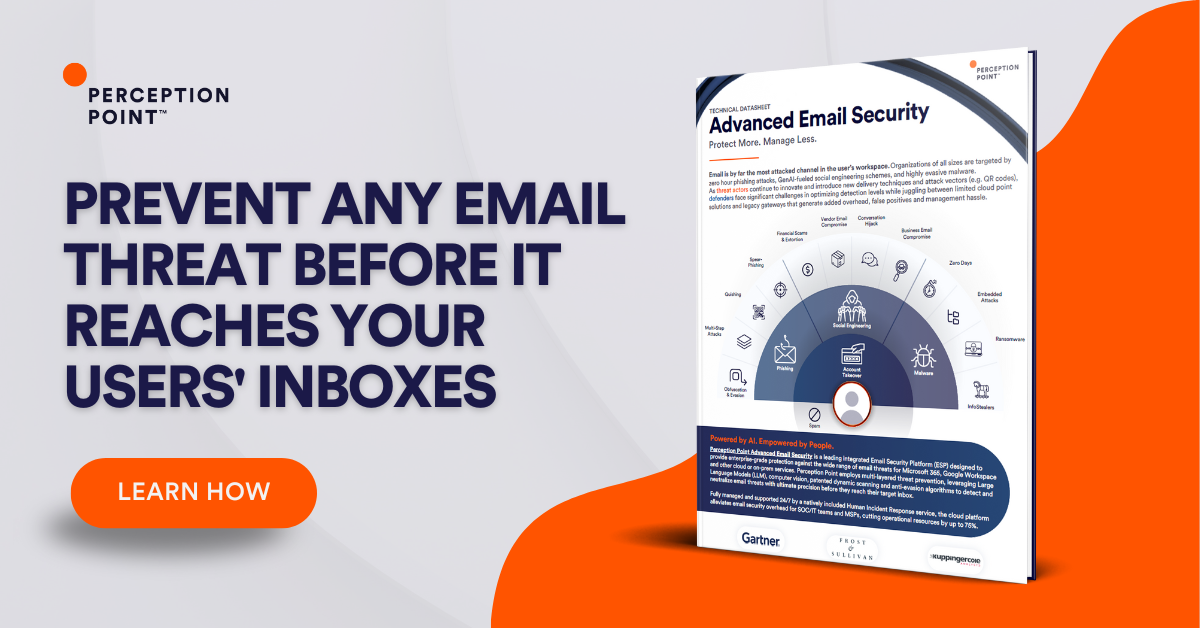What Is Email Filtering?
Email filtering automatically sorts incoming email messages according to criteria set by the email user or an organization’s email administrator. This technology is designed to manage the flow of messages, distinguishing between legitimate emails, spam, promotional content, and potentially harmful messages containing malware, phishing messages, or other threats.
The goal is to improve productivity and security by reducing the clutter in an inbox and protecting users from malicious content.
The criteria used for filtering can vary but often include parameters such as the sender’s reputation, specific keywords, the presence of attachments, and known malware signatures. By applying these filters, email systems can segregate emails into different categories or folders, flag suspicious messages for review, or block dangerous emails from reaching an inbox.
This is part of a series of articles about email security.
In this article
Why Is Email Filtering Important?
Email filtering serves as a critical defense mechanism against the vast array of cyber threats propagated via email, including phishing attacks, malware, and spam. These threats can compromise personal and organizational security, leading to data breaches, financial loss, and damage to reputation.
By filtering out malicious and unwanted emails, individuals and organizations can substantially reduce their risk exposure. Email filtering also helps improve productivity by managing the overwhelming volume of emails that users receive daily. It prioritizes important messages and minimizes distractions caused by irrelevant or unsolicited emails.

Tal ZamirCTO, Perception Point
Tal Zamir is a 20-year software industry leader with a track record of solving urgent business challenges by reimagining how technology works.
TIPS FROM THE EXPERTS
- Implement DMARC, SPF, and DKIM in combination
Ensure your organization adopts and correctly configures Domain-based Message Authentication, Reporting & Conformance (DMARC), Sender Policy Framework (SPF), and DomainKeys Identified Mail (DKIM). This triple-layered approach not only helps in filtering but also in preventing domain spoofing, a common technique in phishing attacks. - Leverage sandboxing for attachment and URL detonation
Employ sandboxing technology to open and analyze email attachments and URLs in a controlled environment before delivering the email to the end-user. This technique is especially useful in detecting zero-day malware or phishing attempts hidden within seemingly benign files or links. - Implement sender behavior analysis for BEC detection Business Email Compromise (BEC) often involves subtle social engineering tactics. By analyzing the behavior of senders—such as tone, request patterns, and email timing—you can spot unusual requests (e.g., urgent wire transfers) that may indicate a BEC attempt.
- Conduct regular phishing simulation exercises
Regularly perform phishing simulations across your organization. The results can be used to tune your email filters more effectively and improve employee awareness, reducing the likelihood of successful phishing attacks. - Establish a clear escalation path for suspicious emails Create a process where users can easily report suspicious emails, and ensure these reports are promptly reviewed by your security team. This feedback loop not only helps in identifying missed threats but also in refining your filtering criteria.
How Does an Email Filter Work?
Email filters scan each incoming and, in some cases, outgoing email based on predefined criteria to determine if it should be delivered to the inbox, redirected to a spam or junk folder, or blocked. This involves analyzing the email’s source, content, and the presence of specific trigger words or phrases.
A typical email filtering process includes these steps:
- Checking the sender’s IP address and domain reputation against databases of known spammers. If an email originates from a denylisted source, it is likely to be flagged as spam.
- Checking the content of the email for characteristics associated with spam or phishing attempts. This includes the presence of suspicious links, unusual use of language, and the inclusion of certain keywords associated with unsolicited messages.
- Most filtering solutions use machine learning algorithms to adapt to new threats by learning from patterns in emails previously marked as spam by users. This allows the email filters to reduce the volume of unwanted messages reaching an inbox.
- Advanced email security solutions can additionally inspect suspicious emails with large language models (LLMs) to identify signs of generative AI or sophisticated phishing attempts.
Types of Email Filtering
Email filters can focus on different types of email threats.
Email Spam Filtering
Email spam filtering targets unsolicited, often irrelevant emails that flood inboxes. These filters check incoming messages to identify and segregate or eliminate spam, using criteria such as known spam signatures, suspicious phrases, and the frequency of identical emails sent across different recipients.
By analyzing these elements, spam filters can distinguish between legitimate correspondence and potential spam, ensuring users’ inboxes remain free from clutter. Advanced email spam filtering solutions also incorporate machine learning and real-time analysis to adapt to evolving spam tactics. They analyze sender behavior, message metadata, and content patterns to predict and intercept new forms of spam.
Graymail Filtering
Graymail refers to emails that are not outright spam but become undesired over time, such as subscriptions or promotional messages that the user initially consented to receive. These messages can clutter an inbox and distract from more important communications.
Graymail filtering solutions differentiate these from spam by analyzing user interaction with received emails, such as open rates and whether the emails are moved to trash without being read. This behavioral analysis helps in categorizing and managing graymail. Advanced email filters allow users to mark messages as low priority or unsubscribe directly through the email client, automating the process of reducing inbox clutter.
Email Phishing Filtering
Email phishing filtering targets attempts by cybercriminals to deceive recipients into exposing sensitive information, such as login credentials or financial details, by masquerading as trustworthy entities. This type of filtering uses algorithms to analyze email content for phishing indicators, including deceptive links, spoofed sender addresses, and the use of urgent or threatening language designed to provoke immediate action from the recipient.
Advanced phishing filters may incorporate machine learning, anomaly detection, and in advanced systems, generative AI technology, to identify new and evolving phishing tactics. By finding deviations from normal communication patterns within an organization, cross-referencing emails against databases of known phishing attempts, and identifying signs of the use of generative AI, these filters can intercept phishing emails before they reach the user’s inbox.
Key Email Filtering Techniques
There are several techniques that can be used to filter emails.
1. Reputation-Based Email Filters
Reputation-based email filters evaluate the reputation of the sender’s domain and IP address against databases known as Reputation Block Lists (RBLs). These lists contain information on sources previously identified as origins of spam, malware, or other security threats. Email messages from domains or IP addresses with poor reputations are blocked or flagged.
This method reduces the volume of malicious emails based on historical data and community-reported incidents. It allows for dynamic updating; as new threats are identified and reported, they are added to RBLs, enhancing the filter’s effectiveness over time.
2. Header Analysis
Header analysis focuses on the metadata contained in the header of an email. This includes the sender’s address, the route taken by the message across servers, and timestamps. By checking this information, filters can identify discrepancies or anomalies that suggest phishing attempts or spam.
For example, a mismatch between the visible sender’s address and the actual sending IP address can be a clear indicator of email spoofing. Additionally, header analysis looks for patterns known to be associated with malicious emails, such as certain headers being missing or formatted in unusual ways.
3. Allowlisting and Denylisting
Allowlisting involves creating a list of approved senders whose emails are always allowed through the filter, ensuring critical communications from trusted sources are never mistakenly blocked. This is particularly useful for avoiding false positives, where legitimate emails are misclassified as spam or malicious.
Denylisting specifies email addresses, domains, or IP addresses from which messages should always be blocked or marked as spam. It prevents known sources of unwanted or harmful emails from infiltrating an inbox.
4. Content Analysis
Content analysis checks the body and subject line of an email for keywords, phrases, or patterns known to be associated with spam, phishing attempts, or other malicious content. This method relies on a database of characteristics commonly found in unwanted emails, including certain trigger words related to advertising, threats, and scams. The filter then determines whether an email should be delivered to the inbox or redirected to a spam folder.
In addition to static rules-based analysis, modern content analysis uses machine learning algorithms that adapt over time. These systems learn from the ongoing classification decisions made by users—such as marking emails as spam or not spam—to improve their accuracy.
5. Antivirus
Email antivirus mechanisms detect and neutralize threats posed by viruses, worms, and other forms of malware transmitted via email. These filters scan attachments and embedded links for malicious code using signature-based detection methods, which compare the content against a database of known malware signatures.
Antivirus filters also use heuristic analysis to identify new or unknown malware by analyzing characteristics and behaviors typical of malicious software. This ensures protection against emerging threats that have not yet been cataloged.
6. Bayesian Filtering
Bayesian filtering involves statistical methods to classify emails as spam or legitimate based on the content of the messages. It works by analyzing the frequency of words and phrases in an extensive collection of known spam and non-spam emails, creating a probabilistic model that predicts the likelihood of a new email being spam.
This method adapts over time, learning from each email it processes to refine its accuracy in distinguishing between unwanted and legitimate messages. Bayesian filtering can personalize spam detection based on the patterns observed in an individual’s email usage. Unlike one-size-fits-all filters, Bayesian techniques evolve with the user’s email habits.
7. Evaluation by Large Language Models
Large Language Models (LLMs) have transformed how email filters identify and combat advanced threats. Advanced email security systems can analyze email content for signs of generative AI use, which is often employed in sophisticated phishing attempts and other malicious activities. By recognizing patterns and structures typical of LLM-generated text, these advanced filters can detect subtle indicators of fraudulent emails.
LLM-based filters employ techniques such as text embedding and clustering algorithms to group similar emails and identify potential threats. This allows the filter to discern between legitimate emails and those generated with malicious intent. Additionally, these filters can assign probability scores to emails, assessing the likelihood of AI generation and potential threat level.
Deployment Options for Email Filtering Solutions
Email filters can be deployed on-premises or in the cloud, or accessed via an MSP.
On-Premises
On-premises email filtering solutions are implemented within an organization’s own infrastructure, providing control over the email security environment. This deployment model involves installing and running the software on physical servers or virtual machines managed by the organization’s IT team. It allows for customization and integration with existing systems.
One of the key advantages of on-premise solutions is data sovereignty, as sensitive information does not leave the organizational boundary, addressing privacy concerns. However, it requires investment in hardware and ongoing maintenance efforts, including updates and patches to keep the system secure against new threats.
Cloud
Cloud-based email filters use a Software-as-a-Service (SaaS) model, offering a flexible approach to email security without the need for on-premise hardware. These solutions are hosted and maintained by the service provider, ensuring that the latest updates and threat intelligence are automatically applied. This option helps minimize IT overhead.
By leveraging cloud infrastructure, these filters provide scalability to meet the demands of growing organizations. They can accommodate changes in email volume, ensuring consistent performance. Cloud-based filters also support remote work environments by securing email access regardless of location or device.
Managed Service Provider
Managed Service Providers (MSPs) offer a simplified approach to email filtering, useful for small to medium-sized businesses lacking extensive IT resources. By outsourcing email security to an MSP, organizations can access advanced filtering technologies and expertise without the overhead of managing these systems in-house.
This model ensures that email protection is always up-to-date with the latest threat intelligence and technological advancements. MSPs handle all aspects of email filter deployment, management, and maintenance, usually through subscription-based pricing models. In addition, providers can offer incident response services to detect and mitigate email-based cyberattacks.
How to Choose Email Filtering Tools
When evaluating email filtering solutions, organizations should consider the following elements.
Security Features
Look for solutions that offer multi-layered defense mechanisms, including antivirus protection, phishing filters, and advanced threat detection capabilities. These tools should be capable of analyzing emails in real time to identify and block malicious content before it reaches the user’s inbox. Prefer tools that offer LLM-based email evaluation, which is effective against the latest generative AI threats.
Another important aspect is the ability of the email filter to integrate with existing security protocols within an organization. This includes compatibility with secure email gateways, data loss prevention (DLP) systems, and incident response platforms.
Accuracy of Filters
The accuracy of email filters is important for ensuring that legitimate emails reach their intended recipients while blocking or flagging unwanted or malicious messages. Effective filtering solutions use algorithms and continuously updated databases to maintain high accuracy levels. These systems must balance sensitivity and specificity—minimizing false negatives (missed threats) without increasing false positives (legitimate emails marked as spam).
Advancements in machine learning and artificial intelligence have improved the accuracy of email filters. By analyzing patterns in large datasets of emails, these technologies adapt and improve over time, becoming better at distinguishing between harmful and harmless messages.
User and Admin Controls
Users should have the ability to mark emails as spam or not spam, contributing to the filter’s learning process and enhancing its accuracy over time. Individual users may need the capability to create personal allowlist and denylists, allowing for greater control over their email experience.
On the administrative side, controls should include comprehensive dashboard capabilities for monitoring email traffic and threats in real time. Admins must have access to tools for adjusting global filter settings, managing user permissions, and defining organizational policies for email handling.
AI-Powered Spam and Phishing Prevention
AI-powered spam and phishing prevention leverages machine learning algorithms and LLMs to analyze email content, sender behavior, and communication patterns to identify and block spam and phishing attempts. This allows for real-time detection of sophisticated threats that traditional filters may miss.
AI models use machine learning to adapt to new spamming techniques and phishing schemes, ensuring high levels of accuracy in threat identification. AI-driven systems can personalize spam detection for individual users or organizational roles, enhancing the relevance of filtering mechanisms. Most importantly, advanced email security systems can identify and block new phishing attacks based on generative AI.
Advanced Email Security with Perception Point
Perception Point is a leading provider of AI-powered Advanced Email Security, safeguarding the modern workspace against sophisticated threats. The unified security solution protects email, as well as web browsers and SaaS apps. By uniquely combining the most accurate threat detection platform with an all-included managed incident response service, Perception Point reduces customers’ IT overhead, improves user experience, and delivers deep-level cybersecurity insights.
Deployed in minutes, with no change to the organization’s infrastructure, the cloud-native service is easy to use and replaces cumbersome, traditional point systems. Perception Point proactively prevents phishing, BEC, ATO, malware, spam, insider threats, data loss, zero-days, and other advanced attacks well before they impact the end-user.

Email filtering automatically sorts incoming email messages according to criteria set by the email user or an organization’s email administrator. This technology is designed to manage the flow of messages, distinguishing between legitimate emails, spam, promotional content, and potentially harmful messages containing malware, phishing messages, or other threats.
Email filtering serves as a critical defense mechanism against the vast array of cyber threats propagated via email, including phishing attacks, malware, and spam. These threats can compromise personal and organizational security, leading to data breaches, financial loss, and damage to reputation.
A typical email filtering process includes these steps:
1. Checking the sender’s IP address and domain reputation against databases of known spammers. If an email originates from a denylisted source, it is likely to be flagged as spam.
2. Checking the content of the email for characteristics associated with spam or phishing attempts. This includes the presence of suspicious links, unusual use of language, and the inclusion of certain keywords associated with unsolicited messages.
3. Most filtering solutions use machine learning algorithms to adapt to new threats by learning from patterns in emails previously marked as spam by users. This allows the email filters to reduce the volume of unwanted messages reaching an inbox.
4. Advanced email security solutions can additionally inspect suspicious emails with large language models (LLMs) to identify signs of generative AI or sophisticated phishing attempts.
Email filters can focus on different types of email threats.
1. Email Spam Filtering
2. Graymail Filtering
3. Email Phishing Filtering
There are several techniques that can be used to filter emails.
1. Reputation-Based Email Filters
2. Header Analysis
3. Allowlisting and Denylisting
4. Content Analysis
5. Antivirus
6. Bayesian Filtering
7. Evaluation by Large Language Models
When evaluating email filtering solutions, organizations should consider the following elements.
1. Security Features
2. Accuracy of Filters
3. User and Admin Controls
4. AI-Powered Spam and Phishing Prevention
























